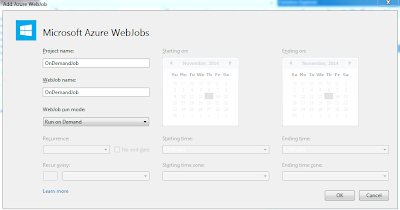Difference between Azure WebJob and a Azure WorkerRole is Azure WebRoles are designed for heavy tasks and WebJobs are designed for light weight tasks.
Currently there are three different ways of scheduling job in Azure WebJobs.
- Continuous
- Scheduled
- On demand
In this demo I'll show how to create various types of WebJobs using Visual Studio 2013.
Create an ASP.net MVC project like below.
Then right click on the WebClient project, in the menu select Add and then select New Azure WebJob Project.
In the popup form, specify the WebJob name and the WebJob run mode. As I have mentioned above there are three types of WebJobs.
First we will create a Run Continuously mode and create a WebJob. This will allow the continuous WebJob to remain in memory so that it can monitor an Azure Storage Queue for incoming messages.
This will add a project to the solution like below.
In the Program.cs file, JobHost will be start up the WebJob and block it from existing. So the WebJob continuously remain in the memory.
In the Functions.cs file, there's a trigger for a AzureQueue called queue. QueueTrigger attribute is used to define a method parameter as one that will be populated when messages land on the Storage Queue being watched by the code. (There are other various attributes for monitor Queues, Blobs, or Service Bus objects.)
Create another project for Run On Demand Azure WebJob like below. These types of WebJobs will run only when a user elects to run the WebJob from within Visual Studio or from the Azure Management Portal.
In the Program.cs file, JobHost doesn't block the WebJob's EXE from exiting. Instead, it presumes a one-time run is needed, and then the WebJob simply exits. And also according to the code this WebJob will run a method called ManualTrigger.
In the Functions.cs file, ManualTrigger methods has defined. There a method attribute called NoAutomaticTrigger which indicates a function for which no automatic trigger listening is performed.










No comments:
Post a Comment